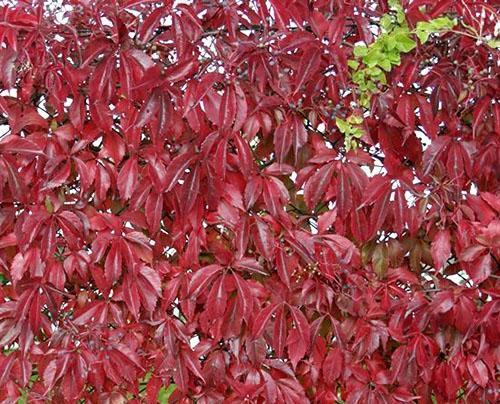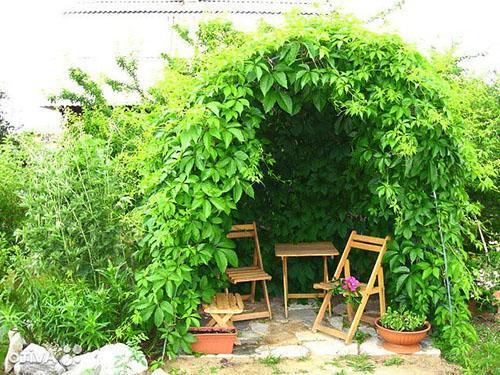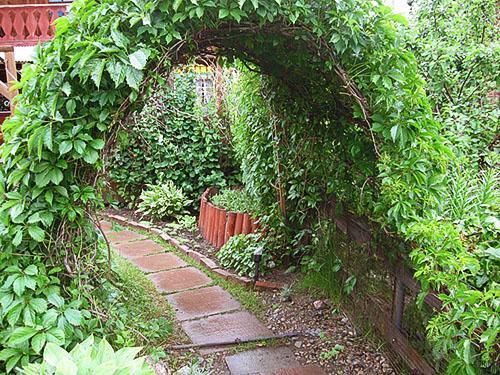Planting in the garden and caring for wild grapes
 The fruits of wild (maiden) grapes are inedible, but the vines of this plant are very decorative. By autumn, the leaves of most varieties acquire a chic burgundy or red color of all kinds of shades and stand out beautifully against the background of the rest of the greenery. The plant is unpretentious to the planting site and the type of soil, but in order to grow lush bushes, you need to follow simple recommendations for planting and caring for wild grapes.
The fruits of wild (maiden) grapes are inedible, but the vines of this plant are very decorative. By autumn, the leaves of most varieties acquire a chic burgundy or red color of all kinds of shades and stand out beautifully against the background of the rest of the greenery. The plant is unpretentious to the planting site and the type of soil, but in order to grow lush bushes, you need to follow simple recommendations for planting and caring for wild grapes.
Where to plant wild grapes

A cultivated soil with any Ph is suitable for planting. If it is planned to plant a plant in an unkempt, overgrown with weeds or rocky area, a spacious planting pit 50 cm wide and deep is prepared, and covered with fertile soil with the addition of humus. This filling will be enough for the plant to grow and receive the necessary nutrition for 2-3 years. After the final rooting, its root system will cope with obstacles on its own.
 Wild grapes, possessing the bulk of the bush, practically does not occupy a useful area, since, when growing grapes in the country, they are planted in places that are unsuitable for the growth of other garden and vegetable garden plants. Vines of maiden grapes are suitable for the following purposes:
Wild grapes, possessing the bulk of the bush, practically does not occupy a useful area, since, when growing grapes in the country, they are planted in places that are unsuitable for the growth of other garden and vegetable garden plants. Vines of maiden grapes are suitable for the following purposes:
- Shading the gazebo.
- The device of a hedge.
- Arch device.
- Decoration of walls of old, dilapidated buildings.
Do not forget that a fast-growing plant needs support, so from the very beginning create conditions for it so that the vines can climb up. This does not apply to those cases when it is planned to let the vines along the ground in the form of a carpet.
How to properly plant wild grapes
 The planting hole is filled ½ part with fertile soil with the addition of humus, and the plant is placed in it. If the soil is loose and fertile enough, it is enough to dig a small hole in which the roots of the grapes can be freely distributed. Having covered the hole with soil, it is poured abundantly with water.
The planting hole is filled ½ part with fertile soil with the addition of humus, and the plant is placed in it. If the soil is loose and fertile enough, it is enough to dig a small hole in which the roots of the grapes can be freely distributed. Having covered the hole with soil, it is poured abundantly with water.
 It should be ensured that the place of the previous growth of the seedling is at the soil level. Deepening the plant will provoke a disorderly formation of shoots, the fight against which will take a lot of time and effort. If the soil subsided after watering, and the bush sank along with the ground, it should be pulled up by gently grabbing the stem near the ground. After that, they fill up the earth and water the plant again.
It should be ensured that the place of the previous growth of the seedling is at the soil level. Deepening the plant will provoke a disorderly formation of shoots, the fight against which will take a lot of time and effort. If the soil subsided after watering, and the bush sank along with the ground, it should be pulled up by gently grabbing the stem near the ground. After that, they fill up the earth and water the plant again.
It is not recommended to transplant a plant more than two years old, as the branching process may be disrupted, and additional pruning will have to be carried out for the correct formation of the bush.
Care of young seedlings of wild grapes
 Plants will take root faster if the soil is constantly kept moist, therefore, during the first week after planting, caring for grape seedlings consists of regular watering. In hot weather, this is done early in the morning or in the evening, and always with warm water.For better moisture retention, it is recommended to mulch the hole with bark or peat.
Plants will take root faster if the soil is constantly kept moist, therefore, during the first week after planting, caring for grape seedlings consists of regular watering. In hot weather, this is done early in the morning or in the evening, and always with warm water.For better moisture retention, it is recommended to mulch the hole with bark or peat.
Young plants cannot resist on their own on a trellis for grapes, so they need to be tied with a soft twine. In a few years, the need for such a garter will disappear, since the plant will independently cling to the fence, the lattice of the gazebo or the wall of the building with antennae or suckers on the stems. Wild grapes need shelter only for the first 2-3 years after planting, after which for the winter you can simply cover the root hole with a layer of humus. You can watch how to care for wild grapes in the video tutorial attached to the article.
Part of caring for girlish grapes is to contain the boundaries of its growth. The plant intensively releases root suckers, which can capture the space not intended for it. In the second half of summer, the bushes are examined several times, and newly formed shoots are dug out. New bushes can be transplanted for further landscaping of the site.
Pruning wild grapes
 In the third year of grape growth, shoots, or stepchildren, begin to form in the leaf axils. The more such processes appear, the more magnificent the bush turns out. Their formation can be stimulated by spring pruning of lashes. Vines are shortened to the required length, and has no restrictions. If you remove most of the shoot, this will not affect the vitality of the vine - it will release side shoots and again reach its previous size.
In the third year of grape growth, shoots, or stepchildren, begin to form in the leaf axils. The more such processes appear, the more magnificent the bush turns out. Their formation can be stimulated by spring pruning of lashes. Vines are shortened to the required length, and has no restrictions. If you remove most of the shoot, this will not affect the vitality of the vine - it will release side shoots and again reach its previous size.
 If you plan to plant trees on the balcony with grapevines, they need to be thrown along the wall of the house and pinched the grapes (remove stepsons) until the vine reaches the desired height. After that, shoots are trimmed from the balcony, which contributes to the growth of green mass. In the spring, all the dried branches are removed, the wind-torn ones are tied up, and too long shoots are shortened. Formative pruning is carried out throughout the first half of the summer, and in the fall, the newly grown ends of the shoots are tied up so that they are not flapped by the wind.
If you plan to plant trees on the balcony with grapevines, they need to be thrown along the wall of the house and pinched the grapes (remove stepsons) until the vine reaches the desired height. After that, shoots are trimmed from the balcony, which contributes to the growth of green mass. In the spring, all the dried branches are removed, the wind-torn ones are tied up, and too long shoots are shortened. Formative pruning is carried out throughout the first half of the summer, and in the fall, the newly grown ends of the shoots are tied up so that they are not flapped by the wind.